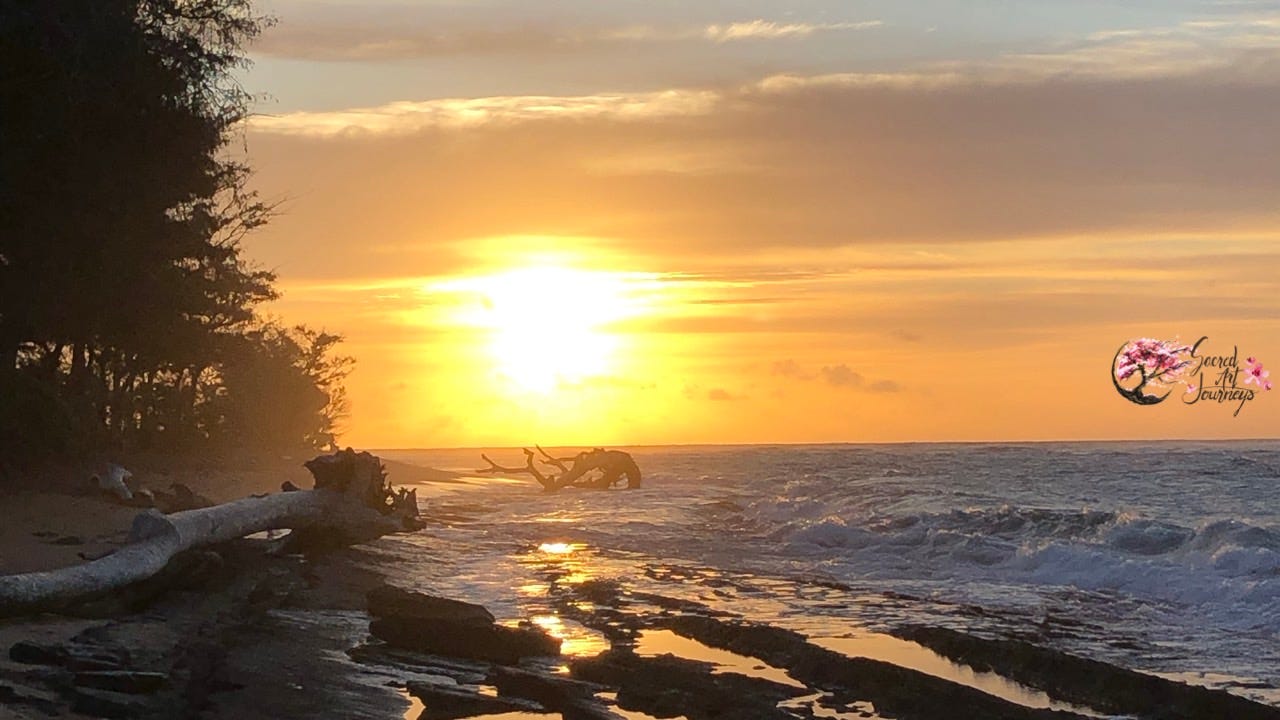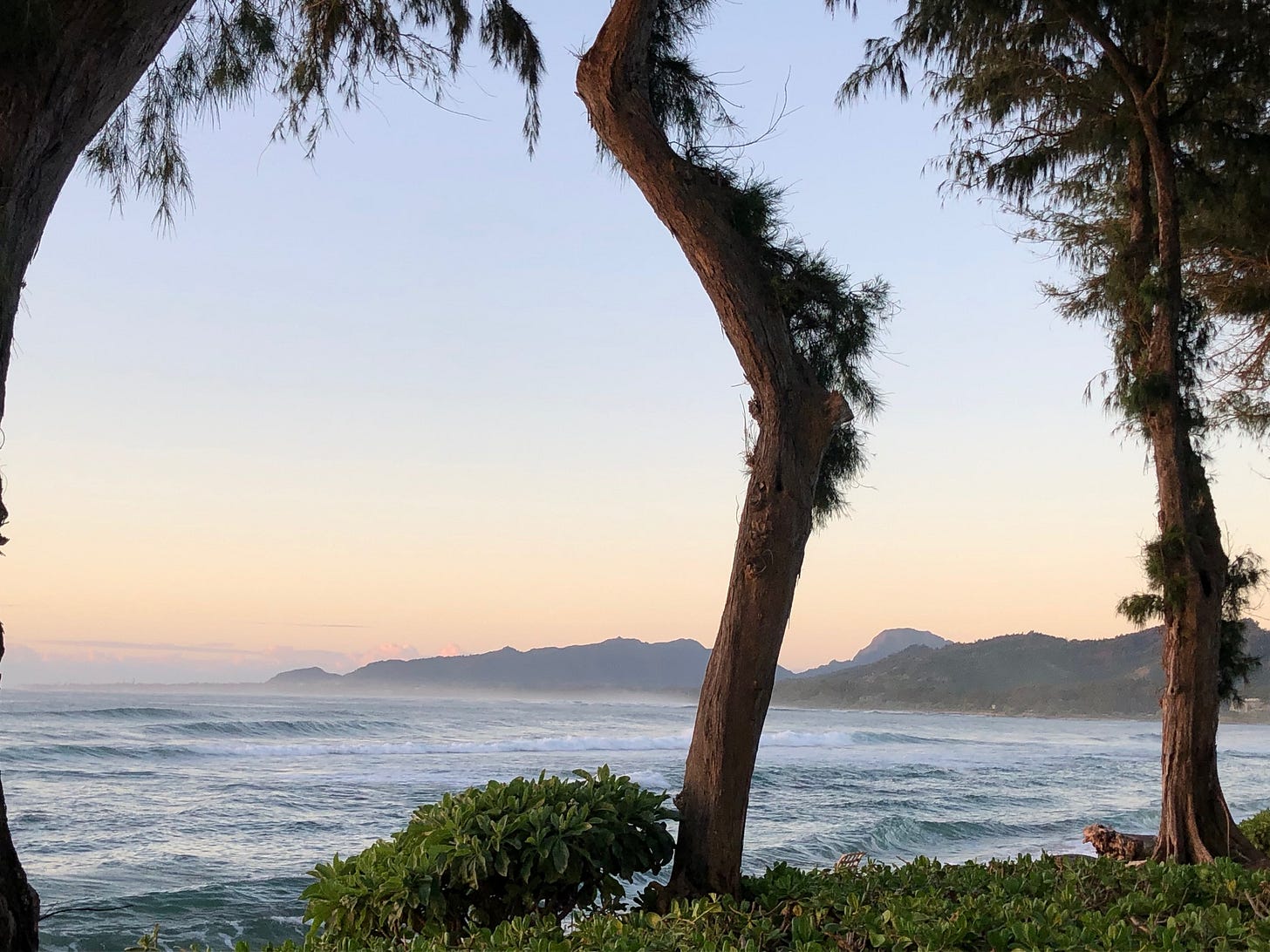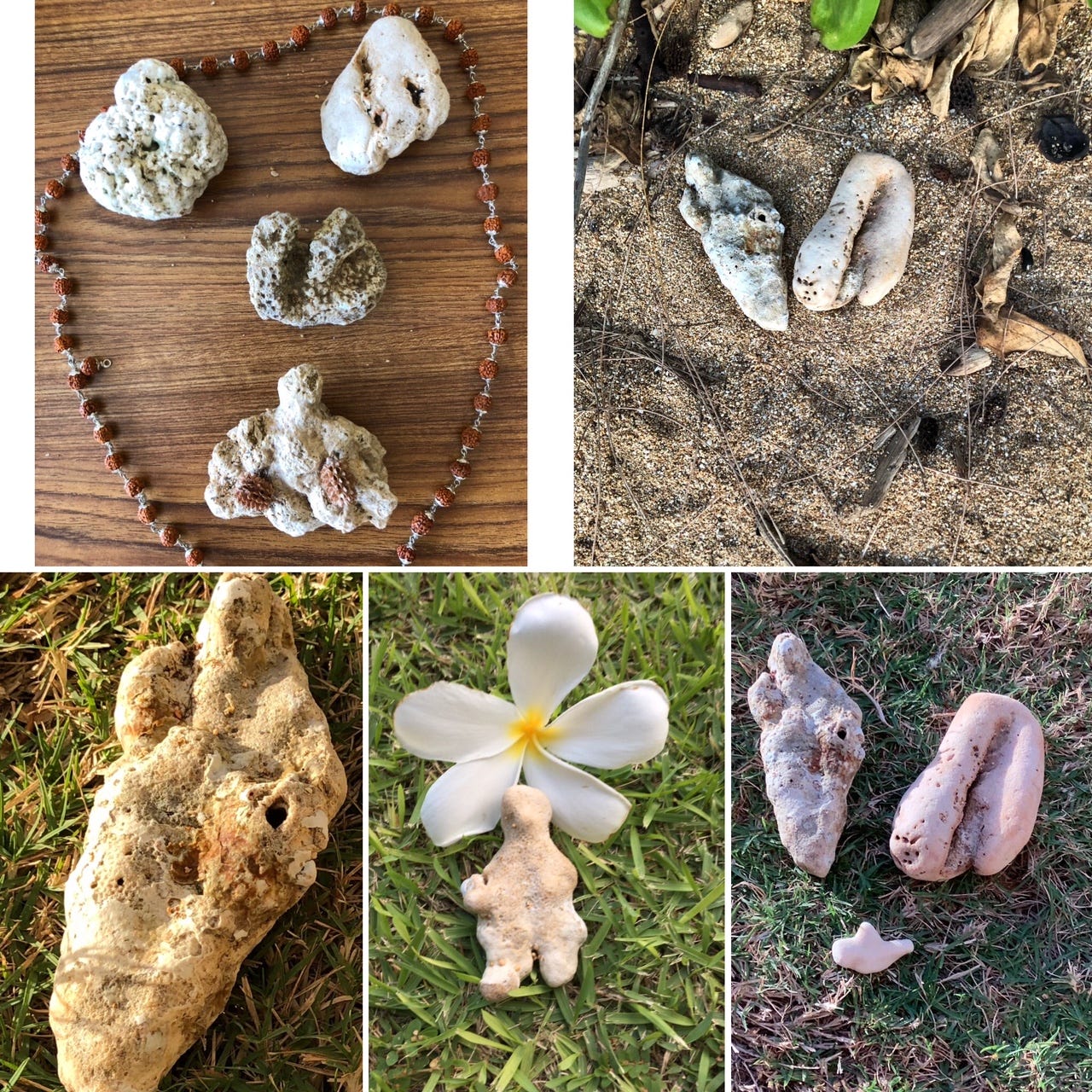For the last twelve hundred years, the small Hawaiian Island of Kauai has been luring adventurers to its crystalline bays and rain-forested mountains. It was the first of the islands settled by voyaging Polynesians, and the first landfall of Captain James Cook. Called “the Separate Kingdom” by the Hawaiians because a treacherous one-hundred-mile channel protected it from invasion by King Kamehameha’s canoeing warriors, Kauai has kept this discrete status. ~ Lucinda Fleeson in Waking Up in Eden: In Pursuit of an Impassioned Life on an Imperiled Island.
I am an island girl. My Caribbean island birthplace of Jamaica will always be near and dear to my heart, but for the past eight years another tropical island has placed me under her spell: Kauai. The Garden Isle of the Hawaiian Islands has revealed herself to be teacher, muse, go-to special place/sit-spot, and fertile ground for cultivating my ecological self. This paper examines Kauai through a terrapsychological lens where I will reflect on the ways this small island in the Pacific Ocean has captured my heart and spirit, inspiring my relationship and apprenticeship to earth as an artist and ecopsychology educator. There is a line in the lyrics from the song Bali Hai in the popular 1958 movie musical “South Pacific” filmed on Kauai which sates: “Your own special island…Bali Hai…you no escape when she call you…” The songwriters Rodgers and Hammerstein struck some truth with that line. Kauai called and I haven’t been able to escape her. I will also examine some of the characteristics of this small island that make her so compelling that many visitors return again and again to her shores.
My first night in Kauai was one of those types of unexpected challenges that turned into divine guidance from another level and a harbinger of many fortuitous synchronicities experienced with Kauai. It was July 2014 and the trip was my reward for having just completed my three year Master’s degree in Women’s Spirituality. I did my research and booked us into a small, quaint sort of hotel opposite from Kalapaki Bay in the main town of Lihue. The reviews were good and it seemed like this would be a centrally located place with easy access to the south coast, east coast and north coast. Arriving at night, we found our way down to the hotel despite some confusing intersections. A friendly front desk person checked us into our room on the second floor. Spacious enough but within half an hour of being in that room we realized this was going to be intolerable. It was hot and humid on the island and the air conditioner in the room was not up to the job, made much worse by the location of the next room’s air conditioning unit positioned in a way that it was heating up the wall to our room. There were no other rooms available in the hotel. Luckily, I had my laptop with me. Through the Hotwire website (https://www.hotwire.com/) I booked us into a new hotel on the east coast for the remaining six nights not knowing where or what it was, as with Hotwire, a place is chosen for you and you have to trust that you’re going to get something decent.
The next morning we drove several miles up the east coast past the airport and a golf course, and on to the graceful Coconut Coast with acres of swaying coconut trees on the inland side and the rough Pacific Ocean with waves breaking and surfers on the right side. Our surprise new accommodations selected for us were in an older resort in Kapaa with Polynesian style buildings in a serene setting with blooming plumeria trees and ALOHA spelt out in the gardens by manicured trimmed hedges. The best feature of all turned out to be the sunrise views over the ocean at the beach fronting the hotel. We’ve stayed at this location ever since and watching the sunrise show every morning over the Pacific with the ever-changing colors and frequent rainbows over the inland mountains has become a daily ritual for us on the island. This east side Kauai coastline feels like a second home to me by now. The sunrises over the ocean are a nourishing healing tonic for my spirit dulled by too much city life.
Another surprise gift of this location being chosen for us was revealed the following year on our second trip. We took a sacred site tour of the island led by a local resident that ended at what we learned was one of the most sacred Hawaiian heiaus, sacred temple sites, on the island. It turned out this heiau is literally a five-minute walk from the place chosen for us to stay on that first trip. Overlooking Wailua Bay, at the confluence of the Wailua River into the Pacific Ocean, the Kukui Heiau is where we respectfully visit, watching sunset daily over the Sleeping Giant Mountain. It is described in the book Ancient Sites of Kaua’i: A Guide to Hawaiian Archaeological and Cultural Places by Van James (2015):
Lae Alakukui, “point of the sent of kukui’ or ‘pathway of kukui,” at the northern end of Wailua Bay is the location of another Wailua Historical District temple- Kukui Heiau. Kukui means “candlenut tree” or “enlightenment.” It is said that a bonfire at this site would light the way for canoes approaching Wailua. Directly across the bay Pu’uhonua o Hauola and Hikinaakala Heiau, this double-sectioned heiau has exceptionally large boulders giving rise to tales of a giant bringing the building materials all the way from the north shore in order to construct the temple walls with seeming ease. (p. 70).
Terrapsychology studies how places get inside of us. Chalquist (2020) defines this field of study: “Terrapsychology is a theory and practice approach that studies, from the standpoint of lived experience, how the world gets into the heart” (back cover). Even as I sit here writing this paper, a text and picture arrives within minutes from my favorite beach on the island. A close friend living on the island sends me texts with photographs from various places occasionally and this one is a picture from Anahola Beach where someone has placed a large piece of coral in the shape of a heart at the base of a tree. Her text said: “this made me think of you.” I had recently shared with my friend photographs of pieces of coral I had picked up on the beach in Kauai, notable because they were shaped like old paleolithic goddesses such as the Venus of Willendorf. I started a practice of keeping these coral goddesses on a small altar while on the island but always return them back to the beach before leaving. Now the coral shaped heart arrived as I write this paper sending a clear message of love from this island that lives in my own heart.
Kauai has responded with other clear messages, dreams and synchronistic events. In 2018 I had just returned from a trip to the island when I received an email invitation to attend the Kauai Writer’s Conference later in the year. I did some processing in my journal and wrote a line to the effect that “if the Goddess wanted to me to back to Kauai that year, then the money would have to show up.” That very night my husband came home with the surprising news that we were to receive a completely unexpected refund of $7,000 on our tax return. Needless to say I was blessed to go back to Kauai for the writers conference.
This small island in the middle of the Pacific Ocean, the most remote set of islands on earth, has a lot to teach us. My professional life for the past nine years has been focused on three interconnected strands of activity: art, ecopsychology education and shamanic energy medicine. Kauai has been my primary guide and muse for all three vocational avenues as my time spent on the island has inspired my creativity and been a source of nourishment and feeling of deep belonging to earth.
My suspicion is that Kauai’s magic has a lot to do with her isolation. Referred to as the Separate Kingdom because she was never conquered by the Kings of the other Hawaiian islands, she has a characteristic of standing apart. The channel between her and Oahu is known to be treacherous and the way the ocean currents run, she was likely settled separately to the other Hawaiian islands when the first Polynesians arrived many hundreds of years ago. Chuck Blay, a geologist whom I had the pleasure of meeting in Kauai has written the definitive geologic history book on Kauai. He notes:
From a myopic human perspective, the islands of Hawaii represent one of the last habitable parcels of land on our planet discovered and occupied by our species. There is little or no direct evidence of human contact of any kind before about 900 CE. The first significant “settlements’ made from the south by ocean voyaging Polynesians were not established until around 1000-1200 CE. (p.1)
It was only during my 7th trip to the island in 2019 that I made the realization that my story with Kauai began before I was even born. In Jamaica, my father played the Hawaiian guitar in a small band in the years prior to my birth and during my very early childhood years. The sounds of the Hawaiian Islands came in utero before I was born. To this day, watching the movie Blue Hawaii featuring Elvis Presley with the sights and sounds of Kauai, resonates in my earliest memories with associations of my father’s guitar playing as he played the songs featured in the movie. One scene in the movie resonates prominently to me as it shows Anahola Beach with the rugged outline of a sacred mountain, Kalalea, in the background. Anecdotally, Kalalea Mountain is referred to by some locals as the ‘Goddess Mountain’ as the mountain has the very distinct shape of a woman lying on her back. Part of the mountain outline also looks like King Kong and was featured in several other Hollywood movies. The ‘Goddess Mountain’ is seen clearly from the air arriving on the island and is one of the places I visit often.
All one has to do today is take even a brief survey of Kauai groups on Facebook (https://www.facebook.com/) and you see the same sentiments repeatedly such as: “I cried when I had to leave.” “As soon as I came home I made arrangements for my next trip.” “I left my soul there.” “I cry when I arrive and I cry when I have to leave.” “I came for the first time last May and I moved there in October.” “I can’t wait to get back.” “I can’t stop thinking of her when I get home.” “The other islands don’t affect me this way.” “I feel at home there.”
How is it that one small island of only 555 square miles affects so many people in this way? Is it possible that the lack of human contact until only fairly recently has something to do with it?
When I went to South Africa on a pilgrimage with spiritual teacher Leslie Temple-Thurston, she referred to the remote unpopulated areas of bush occupied by only the wild animals such as in the Kruger Park as the “African Dreamtime”, the psychic energy of humans being mostly absent and that we could tap into this vast field of wild nature and feel our connection to the land more easily. Brad Laughlin (2019), her partner, describes it further:
The South African lowveld is an extraordinary place, where the virgin bush is so vast and untamed that there are more animals than people. The lack of thought forms fosters deep meditation and a great relaxation of the mind, body and spirit. There, it is easy to let go into the enormity of the inner and outer landscape and experience the mystical nature of the land and animals. We have come to call it the African dreamtime. Entering into the African dreamtime dissolves the separate mind and awakens our interconnectedness with the web of life. It is one of the great gifts that Mother Africa offers to visitors from other parts of the world (p. 195).
I think Kauai has that ‘dreamtime’ quality in spades. The Kauai dreamtime. With less than 75,000 residents and surrounded by a vast ocean, nature is in charge. Humans only arrived on her 1,000 years ago. She’s the oldest island in this remotest of islands in the middle of this ocean, 2.400 miles from any other large land mass. She reminds us of what was before. Before us and our stuff.
I believe that as a species we thirst for this intimate nature contact. I propose that all these people swept up into the magic of being on Kauai, including myself, and compelled to return again and again are emblematic of this thirst in the species for contact, renewal and re-enchantment with wild nature. Hank Wesselman (2011) describes the Hawaiian peoples example and practice:
Hawaiian people live always close to the power of nature and elements, and they do not see themselves as separate from nature. For them, humans are very much part of the natural world in which everything is alive, possessing its own form of conscious awareness. In addressing the awareness of nature and the deities who reside in the islands, prayer permeates the cycles inherent in everyday life, and words and names have power. In fact, names are considered to be living things that contain power in and of themselves. Therefore, the kahuna offer pule (prayer) at every occasion that requires it. Today, such prayers may be in Hawaiian or they may be in English, yet they follow that ancient custom of addressing the gods and the forces of nature through prayer (p. 23).
This reflection paper has been only a brief sketch of ways that Kauai has drawn me in. I remain her willing student and devotee. Words are limited to describe the beauty and power of the island. There is a timelessness that feels tangible and deeply nourishing to my soul on the island. And timelessness is a treasure when received in this modern daily life. And so here, in this place of beauty, and on these tropical shores overlooking a vast ocean, it feels easier to slip into those inward places of presence, where time stands still, where coral goddesses wash ashore on the beaches, where humpback whales show up after dawn on my 60th birthday, and my being gives a grateful exhale.
Postscript: If interested, I share here a link to a presentation I gave at a symposium on May 13/23 held by the East West Psychology Department of the California Institute of Integral Studies where I teach in the Undergraduate Studies Department and am working on my PhD in East West Psychology. I present my sacred art practice which includes some of my latest mixed media artworks from my ‘Kauai Dreamtime’ series. My presentation begins at the 54:00-minute mark on the YouTube video and is 20 minutes long:
Panel 3: Earth - Self and Earth-bodies - YouTube
References
Blay, C., Siemers, R. (2013). Kauai’s geologic history: A simplified overview. The Edge of Kauai Investigations.
Chalquist, C. (2020). Terrapsychological inquiry: Restorying our relationship with nature, place, and planet. Routledge
Cunningham, S. (2009). Cunningham’s guide to Hawaiian magic & spirituality (3rd ed.). LLlewellyn Publications.
Fleeson, L. (2009). Waking up in Eden: In pursuit of an impassioned life on an imperiled island. Algonquin Books.
James, V. (2015). Ancient sites of Kaua’i: A guide to Hawaiian archaeological and cultural places. Mutual Publishing.
Laughlin, B. (2019). Living with enlightenment: A journey of love. CoreLight Publishing.
Wesselman, H. (2011). The bowl of light: Ancestral wisdom from a Hawaiian shaman. Sounds True.









